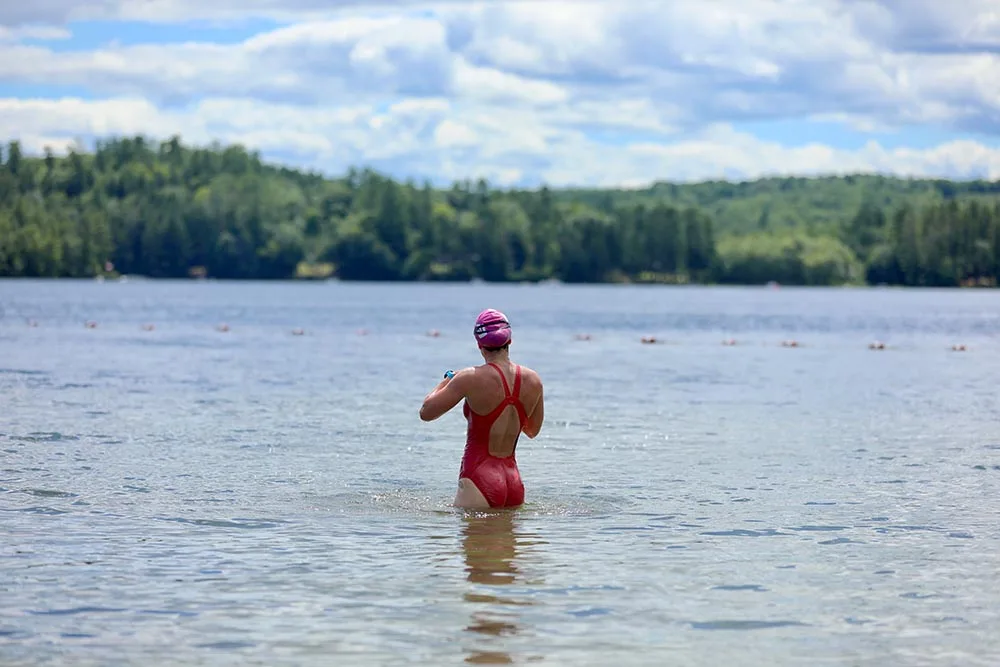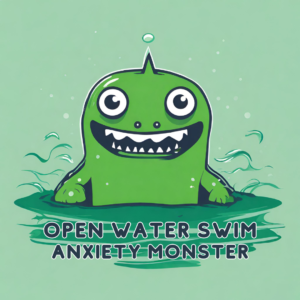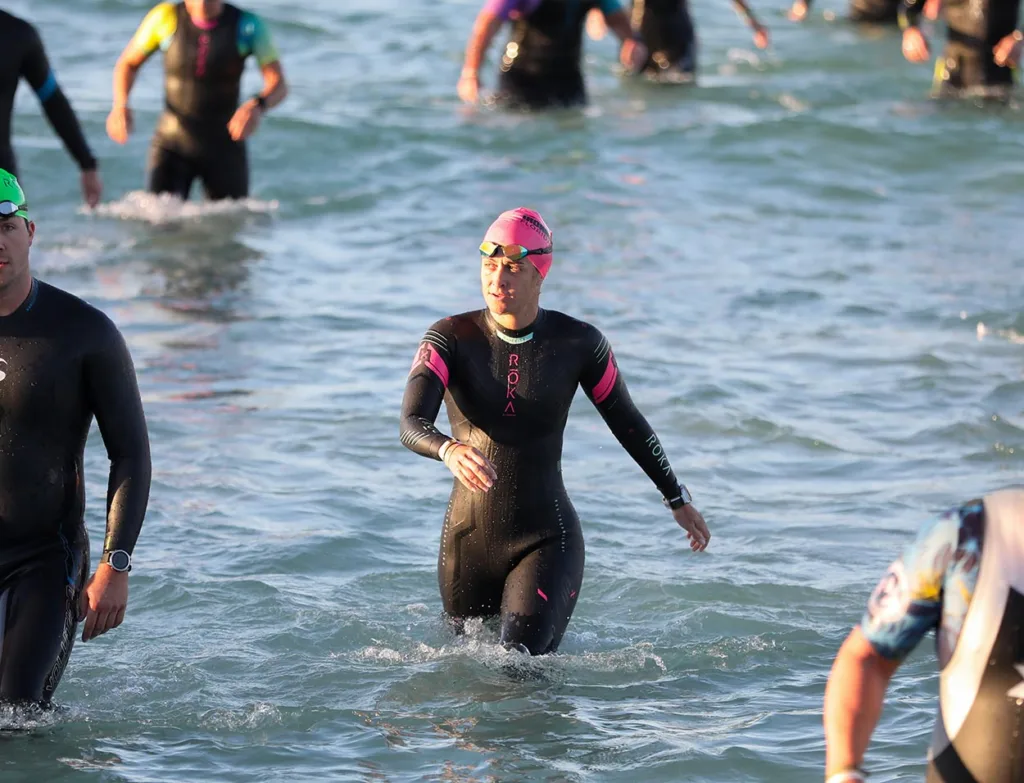
Open water swimming is one of the most polarizing topics in triathlon. You either love it, or you hate it. A lot of it has to do with the fact that most triathletes are adult onset swimmers. I know I am.
I grew up in Florida, so I was always on the boat as a kid. My family went fishing, snorkeling, and tubing, so I’m pretty comfortable in a lake, river, or ocean. But, I didn’t learn how to swim (like really swim) until I started training for my first triathlon in 2019.
And while there are pool-based triathlons, if you have dreams of doing a 70.3 or an Ironman, you’re going to have to swim in open water.
Enter the open water swim anxiety monster! (I imagine he looks a bit like the Creature from the Black Lagoon, all green and scaly with gills.)
Luckily, open water swimming isn’t as scary as it sounds, and it’s something anyone can conquer, with practice.

First, if you suffer from open water swim anxiety, know that you’re not alone. I did an interview with Lauren Brandon, one of the best swimmers in today’s pro triathlon field, and even she doesn’t like open water swimming!
“Swimming in the ocean isn’t my favorite, or many bodies of water for that matter,” Brandon said. “The ocean is kind of scary, to be honest, and I think it’s completely normal for people to feel anxiety when it comes to the open water.”
Yet, she still does it, and she excels at it. That’s the secret, I suppose. You don’t have to like it, but you have to learn how not to let that anxiety control you.
Although I don’t have open water swim anxiety myself, my husband isn’t a big fan. We’ve had to do a lot of work to overcome certain issues related to open water swimming. We did that by watching videos, getting tips from our coaches, and through personal trial and error, because the source of open water swim anxiety isn’t the same for everyone.
Once you pinpoint your specific issue, you can work on ways to conquer it.
5 common causes of open water swim anxiety and how to conquer them:
1.Not putting a wetsuit on correctly
I know what you’re thinking. “How does a wetsuit relate to open water swim anxiety?” or maybe, “There’s a wrong way to put on a wetsuit?”
Yes, there’s a wrong way to put on a wetsuit, and unfortunately it’s something a lot of people do. You don’t put on a wetsuit like you would a pair of pants, by holding onto the waist, sliding your legs in, and pulling the crotch up. You put on a wetsuit like you would a pair of stockings, by putting your foot inside and slowly rolling it up the leg.
If you use the first method, there’s no way to get the wetsuit in the right position on your bottom half, and that will affect the top portion as well. The goal is to get the crotch of the wetsuit up as high up as possible, so it doesn’t pull down on your chest and upper body, which can make your arms and shoulders feel fatigued. It can also lead to a feeling of chest compression, which leads to anxiety.
To put on a wetsuit, push your foot through the opening and pull it up to your calf, then knee, then thigh. Some people cover their feet with a plastic bag or socks to make this easier. Then, reaching inside the suit, slowly work the material up your thigh and as high up to your crotch as possible. (I always have someone reach inside the waist and gently tug to get it even higher.) Finally, work on putting each arm into the suit.
I love my ROKA Maverick X2, because it has little numbers on the kneecap, inside the elbow, and top of the shoulder, so you know you’re putting it in the right spot.

2. Holding your breath
Ever feel like you can’t catch your breath while swimming? A common mistake is not exhaling when your face is underwater. If you don’t exhale, it can quickly lead to a build up of CO2, which causes a feeling of breathlessness, which leads to anxiety.
When I first learned how to swim, my coach gave me this tip: blow bubbles underwater with each exhale, so you know you’re releasing air. The goal is to exhale fully and completely, so when you turn your head to breathe, you only inhale fresh oxygen.
Swimming isn’t like running where you can inhale and exhale anytime you want. You can only inhale when you turn your head to breathe, but you can’t exhale and inhale at the same time.
If you never exhale, you will get out of breath, and likely get anxious very quickly. Don’t mistake mistake oxygen deprivation for exertion. Here’s a great article about how to breathe while swimming, in more detail.
3. Starting out too aggressive
This is Matt’s favorite. If you’re a person who does fine during open water swim practice, but things go a bit pear-shaped during a race, it might be because you’re starting out the swim too aggressively. It’s easy to do, especially when the gun goes off and there’s a bunch of people jostling for position.
Typically, when we swim faster, our arm turnover increases and so does our breathing rate. But breathing too often, in quick, shallow breaths, can lead to a feeling of hyperventilation.
Swimming is different than running in that it’s harder to recover from a bad start. Think about a 5K. When the gun goes off, everyone starts running. All of a sudden, you look down at your watch and realize that you’re going way too fast. But it feels easy! That’s the adrenaline talking and, unless you back off the pace, you will probably regret your decision about 10 minutes later.
But with swimming, it’s a bit harder to judge your pace, especially during a mass start, so it’s very easy to start out too fast. Matt has learned to make a concerted effort to swim slowly during the start of a race, at least for the first 100 yards, until he gets into a comfortable rhythm, and then he can build in pace.

4. Dislike of dark water
The biggest differences between open water swimming vs pool swimming are water clarity, lack of a wall to hold on to, and not knowing what’s down there… At some races, we get to swim in glorious, clear water; but, at others, it’s so dark and murky that you can’t see your hand in front of your face. If you’re used to swimming in a clear pool, that can freak you out pretty quickly.
Swimming in dark water can cause feelings of claustrophobia and anxiety about what creatures might be lurking in the deep, but it’s more than that. Our position often changes in dark water. In a pool, we can see the black line down below, so we push slightly down and forward towards it. But in open water, there’s no line, so we often alter our body position, by lifting the head higher out of the water, which causes the feet to sink and can affect our breathing.
There’s one thing I’ve found that helps. Sit or kneel in waist-deep water and just put your face in. Lift your head up when you need to breathe and take slow and controlled breaths. Do this for a minute or two, or even five, until you feel calm.
Eventually, when nothing bad happens, the adrenaline will subside and the feelings of anxiety will decrease. Your body will get bored just sitting there with your face in the water, doing nothing, and that’s a good thing!
You might feel stupid, but if you can’t sit with your face in dark water and be ok, then swimming in it isn’t going to go any better.

5. Fear of aquatic creatures
This is a hard one, because a fear isn’t always rational. It’s emotional. Because I grew up in Florida, I’m pretty familiar with the behaviors of alligators and sharks. Alligators are aggressive during mating season, when defending their nest, and around smaller animals like dogs. Otherwise, they don’t like commotion caused by people or boats. Sharks can be more predatory, but they’re not fond of water activity either, because they’re very sensitive to underwater vibration.
Once a triathlon starts, and hundreds of swimmers are slapping and kicking the water, there’s little chance of anything being remotely in the same vicinity.
But it’s not just the swimmers. Think about an Ironman that requires support staff in the water on race morning with boats that have to put out buoys, kayakers, and first aid patrol. There’s so much activity in the water prior to the swim even starting that any nearby animal is long gone before you even step foot on the beach.
Those are the big guys, but what about little guys like jellyfish or stingrays? I’ve been stung by many jellyfish, and although uncomfortable, it’s rarely a life threatening thing, unless you have a specific allergy. In that case, one of my friends uses Safe Sea anti-jellyfish lotion and keeps an EpiPen in transition, just in case. You’re very unlikely to run across a stingray while swimming, but more likely to step on it. If you’re swimming off a beach, just shuffle your feet and they will swim away.
Now it goes without saying that you should never swim in open water alone, because there’s safety in numbers, for both protection from any curious creatures and also for boat visibility. But generally, swimming in open water during a triathlon is very safe. I’d be more concerned about watching out for the other swimmers than any aquatic creature.
Hopefully, some of these suggestions will help you overcome, or prevent, open water swim anxiety. It’s really a lot of fun, if you can keep that open water swim anxiety monster at bay!


